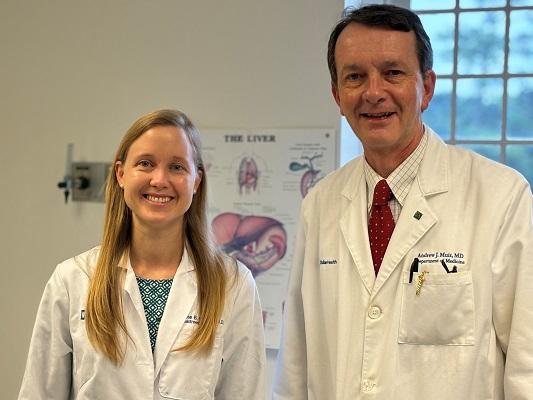
Dr. Jackie Henson, who just began her first year as a Duke gastroenterology faculty member, knows sometimes it’s the little things that matter most.
At her suggestion, Duke University Health System (DUHS) made a simple but systemic change in July to improve the process for hepatitis C virus (HCV) diagnosis by eliminating non-reflex testing as part of the Department of Medicine Quality Initiative for Hepatitis C Elimination for 2023-2024.
In order to evaluate the state of HCV within DUHS and to inform a plan for its elimination, Dr. Henson worked with mentor and Gastroenterology Division Chief Dr. Andrew Muir, to identify gaps where care could be improved. They looked at the whole process, characterizing the five-step HCV care cascade.
They found that barriers to care existed at each stage. The first gap was identified as a lack of confirmatory RNA testing following a patient’s positive antibody test.
Small Changes, Big Impacts
Dr. Henson and Dr. Muir suggested replacing the older two-step process of performing hepatitis C antibody testing alone and then requiring a separate blood draw for RNA testing with hepatitis C antibody with reflex testing in which if the antibody test comes back positive, the RNA test is run automatically. So, from a patient perspective or a clinician perspective, there is one lab test then that takes care of both and they don't need to come back for a second test.
“It's a small system change that could have a big impact on convenience for patients and clinicians, and reducing barriers to hepatitis C treatment,” she said.
“There have been studies that have been done elsewhere that have looked at the cost effectiveness of strategies that basically do reflex testing for all antibody testing and they found that that's more cost effective,” Dr. Henson said. “So, in addition to being more convenient, reducing a barrier, it has been found to be cost effective as well. This presents an opportunity to positively impact the health of these individuals and others with HCV in the future, as well as to prevent downstream complications of hepatitis C that place an increased burden on the health system.”
Dr. Henson noted within the last two years there were nearly 500 patients with positive antibody tests without reflex RNA testing, and these patients were less likely to have subsequent RNA testing, as well as less likely to ultimately be linked to care for their hepatitis C and treated.
HCV Rates Rising Nationally
Despite the availability of effective, well-tolerated medication regimens for hepatitis C virus (HCV), an estimated 1 to 3 million individuals in the United States remain infected, with an estimated 50,000 new infections every year. Left untreated, the virus causes a chronic infection that left untreated can progress to cirrhosis, liver cancer, and death.
The incidence rate of acute HCV has, in fact, more than doubled since 2013 and increased 15% from 2019, a trend that has been observed nationally and locally, Dr. Henson said.
In addition to changing the hepatitis C antibody test ordering, outreach to primary care providers was initiated for Duke primary care patients with untreated hepatitis C (based on a positive RNA test) within the last 2 years. Patient outreach via MyChart was also implemented for the subset of patients with MyChart access, and other strategies to reach these patients are being explored.
A number of additional strategies to improve efficiency and reduce barriers in the HCV treatment process were also made such as attempting to minimize the number of appointments required; promoting the use of telehealth to reduce travel and time barriers; implemented e-consult-based guidance for HCV treatment. Targeted interventions are in process for subgroups.